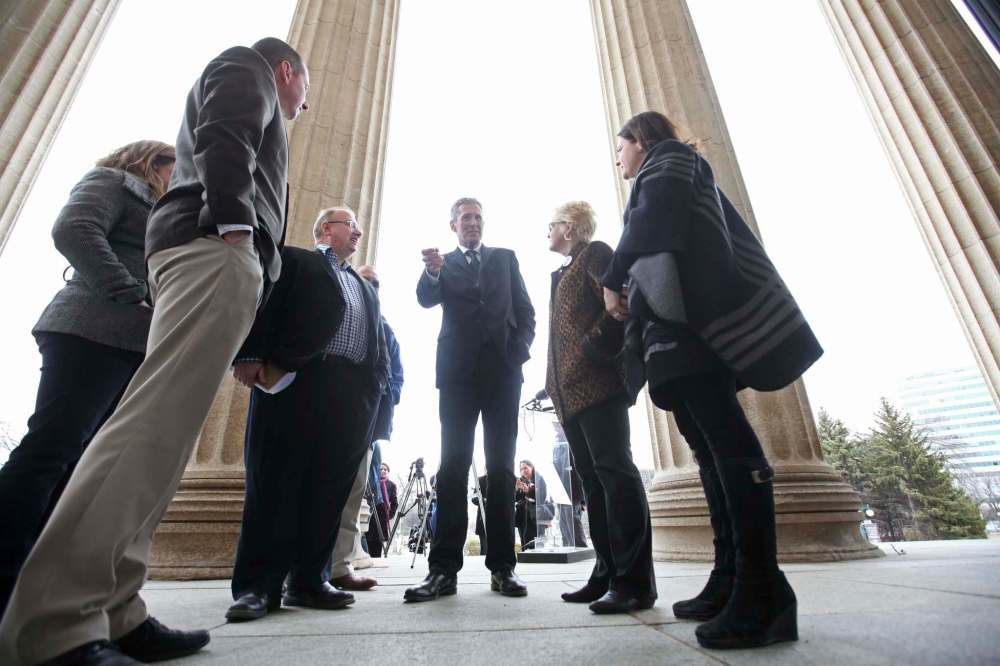Playing the infrastructure card
Pallister's taking calculated risk by suggesting soft cap on spending
Advertisement
Read this article for free:
or
Already have an account? Log in here »
To continue reading, please subscribe:
Monthly Digital Subscription
$1 per week for 24 weeks*
- Enjoy unlimited reading on winnipegfreepress.com
- Read the E-Edition, our digital replica newspaper
- Access News Break, our award-winning app
- Play interactive puzzles
*Billed as $4.00 plus GST every four weeks. After 24 weeks, price increases to the regular rate of $19.00 plus GST every four weeks. Offer available to new and qualified returning subscribers only. Cancel any time.
Monthly Digital Subscription
$4.75/week*
- Enjoy unlimited reading on winnipegfreepress.com
- Read the E-Edition, our digital replica newspaper
- Access News Break, our award-winning app
- Play interactive puzzles
*Billed as $19 plus GST every four weeks. Cancel any time.
To continue reading, please subscribe:
Add Free Press access to your Brandon Sun subscription for only an additional
$1 for the first 4 weeks*
*Your next subscription payment will increase by $1.00 and you will be charged $16.99 plus GST for four weeks. After four weeks, your payment will increase to $23.99 plus GST every four weeks.
Read unlimited articles for free today:
or
Already have an account? Log in here »
Hey there, time traveller!
This article was published 31/03/2016 (3485 days ago), so information in it may no longer be current.
The biggest challenge facing Progressive Conservative Leader Brian Pallister — the man polls tell us will be premier — is his plan to bring fiscal stability to the province doesn’t add up.
Once you combine all the pledges Pallister has made to this point — cutting the PST by one point, preserving core services, slowing the overall rate of spending, enhancing efficiency and eliminating waste in government operations — it doesn’t get him any closer to a balanced budget than the incumbent NDP, which is currently riding a string of seven consecutive deficits. In fact, there is a strong suggestion he might even work himself into a bigger hole than the NDP has dug for itself.
However, in the last week of the campaign, an alternative theory has started to emanate from the Tory camp. It suggests Pallister could be much more successful in bringing fiscal balance back to the province without having to harm core services. How would he do this? By introducing a soft cap in the total amount of money invested in infrastructure.

Pallister has been hinting at this since the first week of the campaign when he said a Tory government would spend at least $1 billion a year on infrastructure. That is a lofty amount, but it’s about $2 billion less than the NDP has committed to spend through to the 2021-22 fiscal year. The NDP has been hammering away at this gap, while Pallister has been shrugging it off but not really explaining his master plan.
This week, however, Pallister was more explicit than ever before on the idea of capping infrastructure spending. In an interview this week, Pallister was asked if he would make an attempt to match NDP levels of infrastructure funding. “I’m not getting into a bidding war with the NDP because it’s not sustainable,” Pallister said after a campaign announcement. “What they’re promising is not sustainable.”
Bingo. With this one statement, Pallister crystallized a plan (to hold the line on future infrastructure spending) and why (not particularly sustainable).
This is Pallister’s riskiest, and smartest, idea to date on how to manage government spending, protect services and bring the budget back into balance. That explains why this larger strategy has been so hard to see.
How is it smart? A soft cap on infrastructure spending could ease some of the upward pressure on total expenditures over the next four years. Pallister has promised to slow the rate of spending in other departments of government; capping the infrastructure portfolio certainly helps with that initiative. But there is one other aspect to this equation that really puts some muscle behind Pallister’s claim he will, eventually, balance the budget.
Infrastructure spending is currently being fed by the NDP’s controversial decision to increase the PST to eight per cent from seven.
One-eighth of the PST generates nearly $300 million a year and grows in total value as the economy grows. Pallister has promised to get rid of the tax sometime in his first term. However, if he is smart, he will wait to the end of that first term and allow the growth in the infrastructure portion of the PST to reduce the need for additional cash or borrowing to feed infrastructure.
A cap on infrastructure spending is also smart because there is a strong, sensible argument for slowing the overall rate of investment. It is potentially helpful to provincial governments struggling to balance their budgets. And it also provides an opening for governments at all levels to get a better handle on exactly what it is they are trying to accomplish with all this money.
There is a growing sense among opinion leaders in local government and construction and business lobbies that we are not spending infrastructure money wisely. That too much of the money is going to filling potholes, expanding road networks or building grade separations, and not enough is going into truly strategic projects that help generate economic growth long after the construction is over.
All that said, this is also an extremely risky move by Pallister and the Tories.
This is Brian Pallister’s riskiest, and smartest, idea to date on how to manage government spending, protect services and bring the budget back into balance
Ramped-up infrastructure spending is politically fashionable right now. The federal government is dumping billions of additional dollars into infrastructure in a bid to jump-start the economy. When that money trickles down, it should exponentially expand the total investment in infrastructure once the provinces and municipalities kick in their shares.
Given the size of the need — municipalities estimate their cumulative infrastructure deficit at somewhere around $125 billion — and the net bump to economic growth from core infrastructure investment, it’s not hard to see why politicians and voters alike have jumped on the bandwagon. By rejecting the notion of having to increase the budget line for infrastructure every year as a matter of course, Pallister is running against conventional political wisdom.
He also runs the risk of angering local government leaders. The Association of Manitoba Municipalities (AMM) is currently running a campaign — “Fair Say, Fair Share” — to convince the winner of this election to increase the total amount of direct grants to cities and towns so they can spend the money as they see fit. Pallister is expected to announce today that although he is willing to give municipalities more input on infrastructure spending priorities, he will not endorse their demand for more direct grants.
If you combine his plan to roll back the PST to seven per cent, his intention to hold the line on infrastructure spending for the foreseeable future, and his rejection of the “Fair Share” campaign, it puts Pallister in conflict with a group of political opinion leaders that could impact the result April 19.
The good news is if he chooses to, Pallister could defend the soft cap on infrastructure spending as a reasonable strategy that would — combined with a reduction in spending increases in other departments — give the province a much better chance of digging itself out of the deficit hole it finds itself in now.
This is a smart and risky plan. The Tories no doubt hope voters embrace the smart and downplay the risky.
dan.lett@freepress.mb.ca

Dan Lett is a columnist for the Free Press, providing opinion and commentary on politics in Winnipeg and beyond. Born and raised in Toronto, Dan joined the Free Press in 1986. Read more about Dan.
Dan’s columns are built on facts and reactions, but offer his personal views through arguments and analysis. The Free Press’ editing team reviews Dan’s columns before they are posted online or published in print — part of the our tradition, since 1872, of producing reliable independent journalism. Read more about Free Press’s history and mandate, and learn how our newsroom operates.
Our newsroom depends on a growing audience of readers to power our journalism. If you are not a paid reader, please consider becoming a subscriber.
Our newsroom depends on its audience of readers to power our journalism. Thank you for your support.












